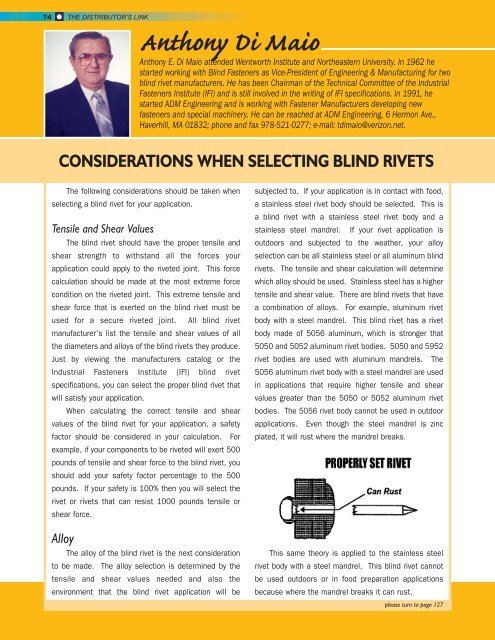SPRING 2012
Distributor's Link Magazine Spring Issue 2012 / VOL 35 / NO.2
Distributor's Link Magazine Spring Issue 2012 / VOL 35 / NO.2
Create successful ePaper yourself
Turn your PDF publications into a flip-book with our unique Google optimized e-Paper software.
74 THE DISTRIBUTOR’S LINK<br />
Anthony Di Maio<br />
Anthony E. Di Maio attended Wentworth Institute and Northeastern University. In 1962 he<br />
started working with Blind Fasteners as Vice-President of Engineering & Manufacturing for two<br />
blind rivet manufacturers. He has been Chairman of the Technical Committee of the Industrial<br />
Fasteners Institute (IFI) and is still involved in the writing of IFI specifications. In 1991, he<br />
started ADM Engineering and is working with Fastener Manufacturers developing new<br />
fasteners and special machinery. He can be reached at ADM Engineering, 6 Hermon Ave.,<br />
Haverhill, MA 01832; phone and fax 978-521-0277; e-mail: tdimaio@verizon.net.<br />
CONSIDERATIONS WHEN SELECTING BLIND RIVETS<br />
The following considerations should be taken when<br />
selecting a blind rivet for your application.<br />
Tensile and Shear Values<br />
The blind rivet should have the proper tensile and<br />
shear strength to withstand all the forces your<br />
application could apply to the riveted joint. This force<br />
calculation should be made at the most extreme force<br />
condition on the riveted joint. This extreme tensile and<br />
shear force that is exerted on the blind rivet must be<br />
used for a secure riveted joint. All blind rivet<br />
manufacturer's list the tensile and shear values of all<br />
the diameters and alloys of the blind rivets they produce.<br />
Just by viewing the manufacturers catalog or the<br />
Industrial Fasteners Institute (IFI) blind rivet<br />
specifications, you can select the proper blind rivet that<br />
will satisfy your application.<br />
When calculating the correct tensile and shear<br />
values of the blind rivet for your application, a safety<br />
factor should be considered in your calculation. For<br />
example, if your components to be riveted will exert 500<br />
pounds of tensile and shear force to the blind rivet, you<br />
should add your safety factor percentage to the 500<br />
pounds. If your safety is 100% then you will select the<br />
rivet or rivets that can resist 1000 pounds tensile or<br />
shear force.<br />
Alloy<br />
The alloy of the blind rivet is the next consideration<br />
to be made. The alloy selection is determined by the<br />
tensile and shear values needed and also the<br />
environment that the blind rivet application will be<br />
subjected to. If your application is in contact with food,<br />
a stainless steel rivet body should be selected. This is<br />
a blind rivet with a stainless steel rivet body and a<br />
stainless steel mandrel. If your rivet application is<br />
outdoors and subjected to the weather, your alloy<br />
selection can be all stainless steel or all aluminum blind<br />
rivets. The tensile and shear calculation will determine<br />
which alloy should be used. Stainless steel has a higher<br />
tensile and shear value. There are blind rivets that have<br />
a combination of alloys. For example, aluminum rivet<br />
body with a steel mandrel. This blind rivet has a rivet<br />
body made of 5056 aluminum, which is stronger that<br />
5050 and 5052 aluminum rivet bodies. 5050 and 5952<br />
rivet bodies are used with aluminum mandrels. The<br />
5056 aluminum rivet body with a steel mandrel are used<br />
in applications that require higher tensile and shear<br />
values greater than the 5050 or 5052 aluminum rivet<br />
bodies. The 5056 rivet body cannot be used in outdoor<br />
applications. Even though the steel mandrel is zinc<br />
plated, it will rust where the mandrel breaks.<br />
This same theory is applied to the stainless steel<br />
rivet body with a steel mandrel. This blind rivet cannot<br />
be used outdoors or in food preparation applications<br />
because where the mandrel breaks it can rust.<br />
please turn to page 127

















